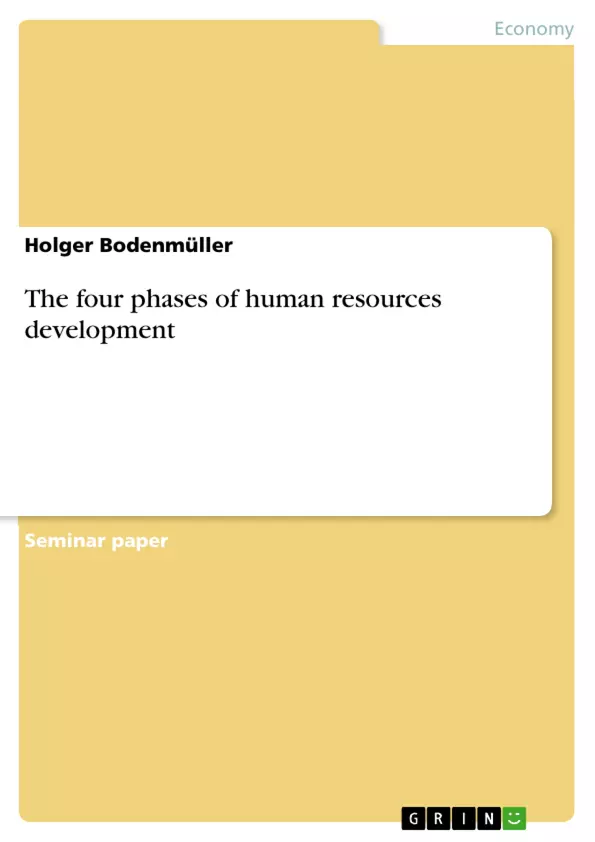Human Resources Development (HRD) is an investment into one of a company’s most important factor for future success: the Human Capital. For a structured approach to HRD the HRD cycle with its 4 stages is introduced: Identification of HRD needs, design of HRD interventions, delivery of HRD interventions, and evaluation of HRD interventions. All stages are briefly described and main models and approaches are mentioned. Finally future challenges of HRD are listed showing that a lot of the major topics prevail challenging in the foreseeable future.
Table of Contents
- Introduction/Problem Definition
- Objectives
- Methodology
- Main Part
- The HRD cycle
- Stage 1: Identification of HRD Needs
- Stage 2: Design of HRD Interventions
- Stage 3: Delivery of HRD Interventions
- Case study BMW AG: Improving Decision-making
- Stage 4: Evaluation of HRD Interventions
- Future Challenges for HRD
- The HRD cycle
- Conclusion
Objectives and Key Themes
This assignment examines the significance of Human Resource Development (HRD) within a company's strategy and success. It introduces the HRD cycle as a structured approach, outlining its four stages: identification of needs, design of interventions, delivery of interventions, and evaluation of interventions. The paper explores key models and approaches within each stage, illustrating their application through a case study at BMW AG. Finally, it highlights future challenges for HRD, emphasizing its ongoing importance in the business landscape.
- The strategic importance of Human Resource Development (HRD)
- The four stages of the HRD cycle and their respective components
- Application of HRD models and approaches within a corporate context
- Case study analysis demonstrating the practical implementation of HRD
- Future trends and challenges in the field of HRD
Chapter Summaries
- Introduction/Problem Definition: This chapter establishes the importance of a skilled workforce as a key competitive advantage for companies. It highlights significant investments in education and research by both the German government and private businesses, emphasizing the strategic importance of human capital development.
- Objectives: This chapter outlines the specific goals of the assignment, focusing on exploring the HRD cycle, its four phases, and its contribution to corporate strategy.
- Methodology: This chapter details the research methods employed in the assignment, including the theoretical framework, data sources, and analytical techniques used to study the HRD cycle.
- The HRD cycle: This chapter introduces the HRD cycle as a structured framework for human resource development. It describes each of the four phases, emphasizing the key models and approaches used in each stage.
- Stage 1: Identification of HRD Needs: This chapter explores the first stage of the HRD cycle, focusing on the identification of training needs. It discusses methods like Training Needs Analysis (TNA) and the Systematic Training Cycle (STC) to assess training requirements effectively.
- Stage 2: Design of HRD Interventions: This chapter analyzes the second stage of the HRD cycle, delving into the design of HRD interventions. It examines various models and methods like the ADDIE model (Analysis, Design, Development, Implementation, Evaluation) for creating impactful training programs.
- Stage 3: Delivery of HRD Interventions: This chapter explores the third stage of the HRD cycle, focusing on the delivery of HRD interventions. It examines different delivery methods like classroom training, e-learning (WBT, CBT), and blended learning, highlighting their effectiveness and potential limitations.
- Case study BMW AG: Improving Decision-making: This chapter provides a case study example from BMW AG, demonstrating the application of the HRD cycle to address a specific training need. It outlines the process of developing a training program to improve the quality of decision memos for board decisions.
- Stage 4: Evaluation of HRD Interventions: This chapter discusses the final stage of the HRD cycle, focusing on evaluating the effectiveness of HRD interventions. It explores various evaluation methods and metrics like ROI (Return on Investment), KPI (Key Performance Indicator), and Kirkpatrick's Levels of Evaluation for assessing the impact of training programs.
- Future Challenges for HRD: This chapter looks ahead, addressing the future challenges facing HRD. It considers factors like technological advancements, globalization, and changing employee expectations, emphasizing the need for ongoing adaptation and innovation in HRD practices.
Keywords
This paper focuses on the crucial concept of Human Resource Development (HRD) and its strategic role within companies. It examines the four phases of the HRD cycle: needs identification, design of interventions, delivery of interventions, and evaluation of interventions. Key terms explored include Training Needs Analysis (TNA), Systematic Training Cycle (STC), ADDIE model, Return on Investment (ROI), Key Performance Indicator (KPI), and Kirkpatrick's Levels of Evaluation. The paper utilizes a case study from BMW AG to illustrate the practical implementation of the HRD cycle, highlighting its relevance within the context of a real-world business setting.
- Quote paper
- Holger Bodenmüller (Author), 2011, The four phases of human resources development, Munich, GRIN Verlag, https://www.grin.com/document/271647



